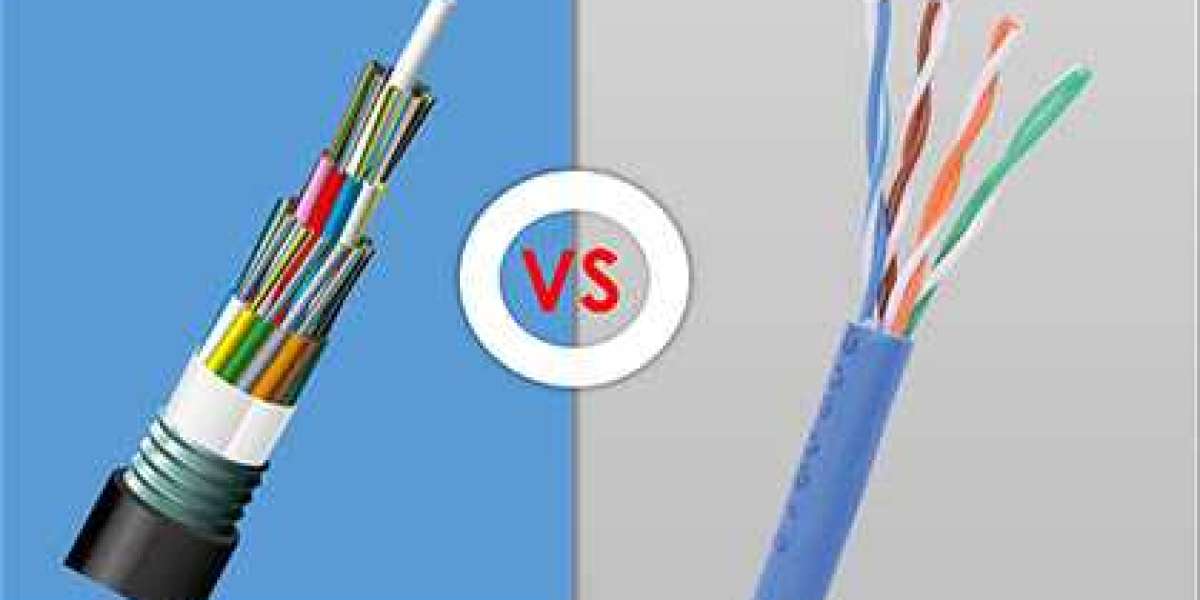What is a Fiber Optic Cable?

A fiber optic cable is a type of network cable that uses light to transmit data. Unlike traditional copper cables, which rely on electrical signals, fiber optic cables carry data as pulses of light, typically generated by lasers or LEDs. These cables are made up of tiny strands of glass or plastic fibers, each about the diameter of a human hair. The primary advantage of using light instead of electricity is that light signals travel faster and farther without degradation, allowing for much higher data transfer rates and reliability.
Each fiber in a fiber optic cable is composed of three main components:
- Core: The innermost part where light signals travel. The core is made of ultra-pure glass or plastic.
- Cladding: Surrounding the core is the cladding, a material that reflects light into the core, ensuring the signals don’t escape and are transmitted efficiently.
- Coating: A protective layer that shields the core and cladding from damage and external interference.
How Fiber Optic Cables Work
Fiber optic cables transmit data through a process known as total internal reflection. When light signals enter the core, they bounce off the cladding, which keeps the light contained within the core. These signals travel through the cable without loss of data over long distances, making them ideal for high-speed, high-volume data transmission.
Key Steps in Data Transmission:
- Conversion to Light: Electrical signals from a device are converted into light signals by a transmitter.
- Transmission through Fiber: The light signals are sent through the core of the fiber optic cable.
- Reception and Conversion: At the destination, the light signals are converted back into electrical signals by a receiver.
This entire process happens at incredible speeds, enabling fiber optic cables to support bandwidths far beyond those of traditional copper cables.
Types of Fiber Optic Cables

There are two primary types of fiber optic cables: Single-Mode Fiber (SMF) and Multi-Mode Fiber (MMF). Each serves different purposes based on the distance and bandwidth requirements of the network.
Single-Mode Fiber (SMF)
Single-mode fiber has a smaller core (typically around 8 to 10 microns) and allows only one light path, or mode, to pass through. This makes SMF ideal for long-distance communication, as it reduces signal attenuation (loss of signal strength) over large distances. Single-mode fiber is commonly used in telecommunications and wide-area network (WAN) applications, where data needs to travel long distances without degradation.
Multi-Mode Fiber (MMF)
Multi-mode fiber has a larger core (about 50 to 62.5 microns), which allows multiple light paths or modes to travel simultaneously. This results in higher bandwidth but limits the distance over which data can be effectively transmitted. Multi-mode fiber is often used for short-distance communication, such as in local area networks (LANs) and data centers.
Advantages of Fiber Optic Cables
The shift from copper to fiber optic cables offers several key advantages, making them the preferred choice for modern data transmission:
Higher Bandwidth
Their ability to handle higher frequencies of light allows for much greater bandwidth, meaning more data can be transmitted at faster speeds.
Longer Distance
Fiber optic cables can transmit data over significantly longer distances without losing signal quality. While copper cables may experience signal degradation after a few hundred meters, fiber optic cables can carry signals for miles before requiring amplification.
Faster Speeds
Since light travels faster than electrical signals, fiber optic cables provide higher data transmission speeds. This makes them ideal for real-time applications like video streaming, online gaming, and cloud computing, where latency can be a critical factor.
Immunity to Electromagnetic Interference (EMI)
Copper cables are susceptible to electromagnetic interference (EMI), which can disrupt data transmission. Fiber optic cables, on the other hand, are immune to EMI because they use light signals instead of electrical currents. This makes them more reliable, especially in environments with heavy electrical equipment.
Durability
Fiber optic cables are resistant to harsh environmental conditions such as temperature fluctuations, moisture, and corrosion. This makes them suitable for outdoor and industrial applications.
Applications of Fiber Optic Cables
Fiber optic cables have become an essential component in various industries due to their superior performance and reliability. Some key applications include:
Telecommunications
Fiber optics play a vital role in the backbone of global telecommunications, enabling faster, more reliable phone and internet services. With the increasing demand for high-speed internet and 5G networks, fiber optics have become indispensable.
Healthcare
In the medical field, fiber optic cables are used in endoscopic imaging, surgical equipment, and other devices that require precise, high-resolution data transmission.
Military and Aerospace
Fiber optic technology is employed in military and aerospace applications due to its security, resistance to harsh environments, and high-speed communication capabilities.
Data Centers
As data centers grow in complexity, fiber optic cables are used to support the immense data transfer requirements, offering low latency and high-speed connections.
Conclusion
Fiber optic cables have become the gold standard for modern communication systems, offering unparalleled speed, bandwidth, and reliability. As the world becomes increasingly connected, the demand for faster, more secure, and efficient data transmission will continue to grow, cementing the role of fiber optics in the future of global networking. Whether for telecommunications, data centers, healthcare, or beyond, fiber optic technology is paving the way for a faster, smarter, and more connected world.













